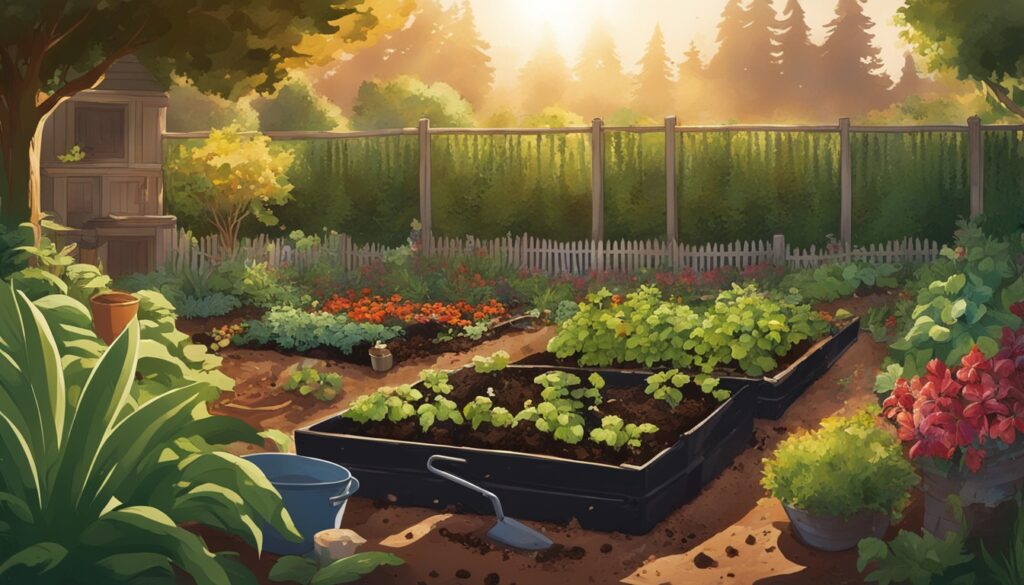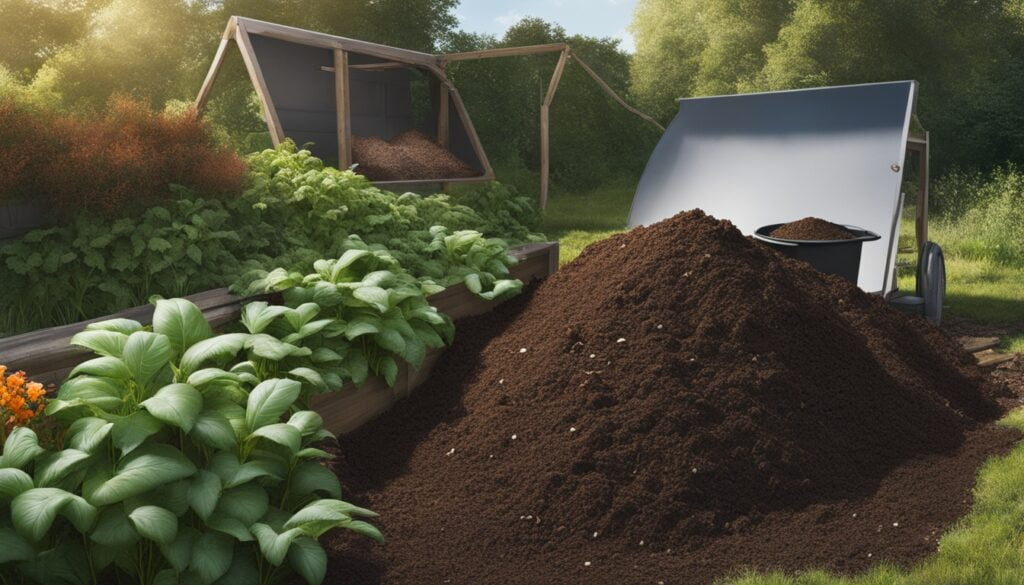Almost 30% of our trash is compostable. This includes kitchen scraps and yard waste. By composting, we can turn this waste into rich soil for our gardens. Advanced composting techniques help us make the most of this natural process. They offer great ways to improve soil fertility and practice sustainable gardening.
Organic methods such as hot and cold composting can speed up the decomposition of waste. This improves soil health. In addition to aiding plant growth, it keeps soil moist and helps control weeds. Making and using “black gold” – a dark, nutrient-packed compost – benefits the garden for years.
Caring for the tiny organisms in compost and choosing the right mix of materials is crucial. Good composting helps their work and improves the garden’s health. When we compost, we don’t just make our garden better. We also help the environment by using waste wisely and feeding life in the soil.
Key Takeaways
- 30% of household waste can be composted, turning waste into nutrient-rich soil.
- Hot and cold composting methods improve soil structure and plant health.
- Creating “black gold” compost serves as a natural fertilizer, retaining moisture and suppressing weeds.
- Sustainable gardening practices help reduce waste and improve the nutrient cycle within ecosystems.
- Effective management of compost ingredients supports beneficial microbes and enhances garden vitality.
The Basics of Composting
Composting is a way to turn waste into soil that’s full of nutrients. This happens naturally as organic materials break down with the help of little creatures like earthworms and ants. Adding compost to soil is a key way to make gardens better. It gives the soil a boost in health.
What is Composting?
Composting is how organic materials turn into dark, sweet-smelling soil. Some call this final product “black gold” because it’s so good for plants. It’s a way to recycle kitchen peels and grass cuttings into something useful. This process makes the ground richer, healthier for plants.
Benefits of Compost
Using compost in a garden has lots of pluses. First, it gives the soil many nutrients that plants need to grow well. It also makes the soil easier for plants to take in water and air. Good soil from compost helps small helpful organisms live there, making everything in the garden more balanced. In the end, using compost means better plant health and more produce.
Ingredients Needed for Composting
To start composting, gather items rich in carbon and nitrogen. Carbon items, called “browns,” are stuff like dry leaves and cardboard. Nitrogen items, or “greens,” are things like grass and vegetable waste. You also need to keep the compost mix damp and filled with air. This helps the tiny creatures break down the waste faster.
Here’s a simple way to group the things you can compost:
| Carbon-Rich (Browns) | Nitrogen-Rich (Greens) |
|---|---|
| Dry leaves | Grass clippings |
| Straw | Vegetable scraps |
| Cardboard | Coffee grounds |
| Sawdust | Fruit peels |
If you mix the compost ingredients right, you’ll turn trash into treasure. Your plants will love it. Start composting today and see your garden thrive!
Understanding Carbon and Nitrogen Ratios
Getting the right mix of carbon and nitrogen in your compost is key. It helps the good microbes live well and break down the stuff you want gone.
Importance of Balance
Having the right amount of carbon to nitrogen, about 25:1, is super important. Carbons give energy, and nitrogens offer protein. This keeps your compost working well, without bad smells or slow decay.
Examples of Brown and Green Materials
Recognizing “brown” and “green” stuff is vital for a healthy compost. Browns have lots of carbon, like corncobs and straw. Greens are high in nitrogen, like food scraps and grass. Mixing these well keeps your compost full of good microbes, helping it stay useful.
Hot Composting Methods
Hot composting is a great choice for those who want to improve their compost game. It’s known for getting very hot, which helps break down materials quickly. This heat also kills off weed seeds and pathogens, making your compost safe and nutritious.
High-Temperature Benefits
One big plus of hot composting is how fast it works. It can hit 160°F, breaking down waste in no time. Plus, this heat kills bad bugs and fungus, giving you good compost to feed your plants.
Steps to Achieving Hot Compost
Making hot compost is all about the right steps. Start by collecting a lot of waste, both ‘greens’ and ‘browns’. Mixing it up well and turning the pile often keeps the process going.
- Assemble organic materials with a 30:1 carbon-to-nitrogen ratio.
- Build the pile to be at least 3 feet by 3 feet to retain heat.
- Monitor and maintain moisture content, aiming for a consistency similar to a damp sponge.
- Turn the pile every few days to introduce oxygen and sustain high temperatures.
- Use a thermometer to ensure the core temperature stays around 160°F.
Common Mistakes in Hot Composting
But, even with the best plans, mistakes can pop up. For example, using too much green or brown waste can slow things down and smell bad. Also, not enough turning can cut off oxygen, causing the pile to stink. Making sure there’s enough air and water is vital for avoiding these problems.
| Issue | Impact | Solution |
|---|---|---|
| Disproportionate Brown to Green Ratios | Slow decomposition and odor problems | Maintain a balanced 30:1 carbon-to-nitrogen ratio |
| Inadequate Aeration | Anaerobic conditions cause strong odors | Turn the pile regularly |
Cold Composting Methods
Cold composting is a simple way to make your garden better. You just pile up garden waste and kitchen scraps. Then, let them decompose naturally. Unlike hot composting, you don’t need to turn it often or watch the temperature. This method is great for those who like to relax and let things happen on their own over months or even years.

Cold composting is slow but it works well for gardening with compost. You need to be patient. The waste will slowly turn into nutrient-rich compost. This helps improve your soil. It’s also a good way to garden sustainably, making use of what you might throw away easily.
Vermicomposting: Using Worms for Superior Compost
Vermicomposting is a smart way to compost, using worms to turn food scraps into rich soil. It’s good for the plants and environmental too. Gardeners love it because it boosts their plants with extra nutrients.
Choosing the Right Worms
Picking the right worms is key for vermicomposting. Go for red wiggler worms since they are great at eating up food scraps. They also do well in different temperatures, making them perfect for composting.
Setting Up a Worm Bin
Starting a worm bin is easy. Just grab a container and line it with bedding like shredded paper. This bedding keeps the worms healthy. Add your red wiggler worms and food scraps slowly. This helps maintain a healthy environment for them.
Maintenance and Harvesting Tips
To keep your vermicompost system working well, feed your worms and watch the moisture. This stops bad smells and keeps pests away. Use your kitchen scraps and leaves. Do this to get great soil as a result.
Every few months, you can collect your hard work. This nutrient-rich soil helps plants grow strong and healthy.
No-Dig Gardening and Compost
No-dig gardening is all about keeping the soil healthy with less work. It’s a method that lets the tiny life in the soil, like microorganisms and earthworms, really do their job well.

Benefits of No-Dig Gardening
No-dig gardening reduces the hard work and time needed in traditional gardening. You don’t have to dig the soil, which keeps it healthy. It also helps the soil hold onto water better, important for your plants.
Not disturbing the soil lets all the good organisms in it live well. This keeps your garden fertile naturally.
How to Start No-Dig Composting
Starting a no-dig garden is easy. Clear out and level the space. If it’s new, put down cardboard to stop weeds. Then, just layer with compost and other organic stuff. You won’t need to dig at all.
Long-Term Maintenance of No-Dig Beds
Keeping no-dig beds healthy is simple but key. Adding compost once a year is enough to feed your soil. This keeps the earthworms and other helpers happy. By doing this, your garden will stay rich and productive.
Dealing with Compost Pests and Problems
Keeping a compost pile in shape calls for careful work, especially dealing with compost pile maintenance. It’s often hard to avoid smells and pests. Bad scents mean the mix of green and brown stuff is off. The right mix not only prevents smells but also helps things break down well.
Getting rid of unwanted critters needs a few steps. Turning the compost often is key because air deters pests. Also, using a container with a lid stops animals from getting in.
Choosing the right place for the pile is a big part of compost pile maintenance. Put it far enough from your home or garden. This stops pests from causing trouble.
| Problem | Solution |
|---|---|
| Odors | Balance of greens and browns, and regular turning |
| Rodents | Enclosed compost bin with a secure cover |
| Insects | Maintain aeration through regular turning |
Advanced Composting Techniques for a Healthier Garden

I’m learning about advanced composting methods to change trash into nutrient-filled soil. Using both hot and cold composting, I make the most of my compost. This way, my garden benefits a lot.
Hot and Cold Composting Combo
By combining hot and cold composting, I get the best of both worlds. Hot composting works fast at high temps. Cold composting takes its time but is easier to keep up with. Both together give me a steady stream of rich compost.
Using Diverse Organic Matter
Adding lots of different organic materials makes the compost better. I toss in yard waste, kitchen scraps, and even animal leftovers like fish parts. This mix boosts nutrients and brings in more helpful tiny life. In the end, this turns my trash into top-quality soil well.
Composting Animal Byproducts
Dealing with animal remains in compost needs careful steps. Using advanced hot composting is key to making sure things get hot enough to kill germs. With this method, my compost is both rich and safe for gardening.
Thanks to these methods, I’m making my compost super beneficial. This means a garden that’s not just pretty but healthier too.
Conclusion
Learning about advanced composting has been eye-opening. It’s all about making your garden healthy in unique ways. You can choose from hot, cold composting, vermicomposting, or no-dig gardening. Each way boosts soil quality and helps plants grow strong.
It’s crucial to keep a good mix of carbon and nitrogen and manage your compost pile well. Adding worms to vermicomposting increases the benefits. These methods give you choices based on your garden’s needs and upkeep ability. By using these tips, your garden will thrive and stay healthy.
Taking up sustainable garden practices is not just good for your plants but also for the planet. It cuts down on waste and puts organic matter back into your garden. This way, your garden becomes its own ecosystem.
It takes time and the right approach, but the result is a beautiful garden. You’re also helping make the world less wasteful and more green. These techniques turn your trash into treasure for your garden, benefiting it for many seasons.





